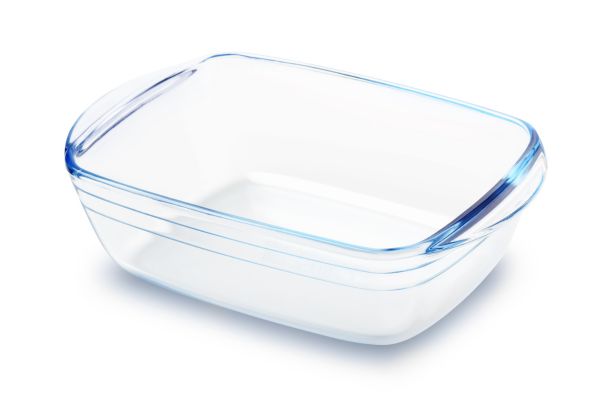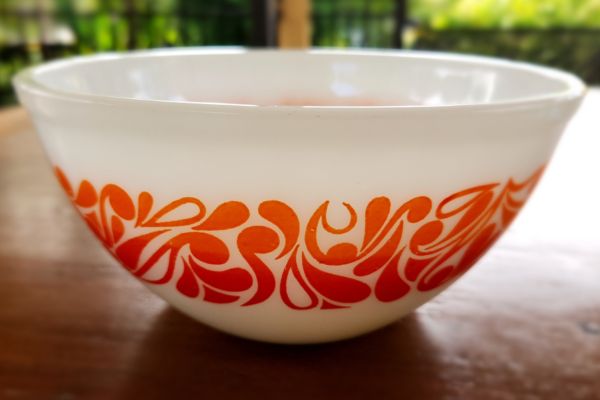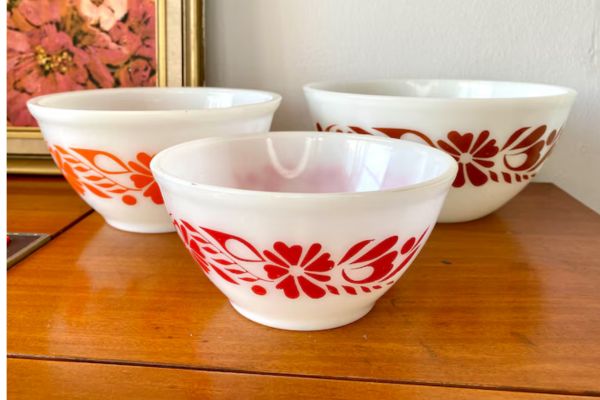If I were inclined to be a collector, I would definitely collect old Pyrex baking dishes. I got this wonderful old Pyrex dish (the one in the photo above) a few years ago, and I adore it. Baking dishes and Pyrex bowls have a certain rustic charm. They’re not only beautifully designed but they’re made with such quality that you would think they would last forever. Sadly, they eventually come to the end of their lives. This is when you might wonder is Pyrex recyclable?
In this article I’ll explain how Pyrex is made and how it can withstand such high temperatures and still remain in tact. Then I’ll cover the ins and outs of disposing of pyrex containers.
The Birth of Pyrex
The introduction of the Pyrex brand by Corning Inc. in 1915 played a crucial role in popularizing borosilicate glass among consumers.
Borosilicate glass was invented in the late 19th century by German chemist Otto Schott and his colleagues at Schott AG. Its unique composition, containing silica, boric oxide, sodium oxide, and aluminum oxide, demonstrated exceptional properties such as high thermal shock resistance, chemical inertness, and optical clarity, making it ideal for laboratory glassware and optics.
Corning acquired the rights to manufacture borosilicate glass from Schott and began producing Pyrex glassware for household use. Pyrex quickly became synonymous with quality and reliability in kitchens worldwide, offering consumers durable and versatile glassware. Its robust nature was not only suitable for hot and cold applications without the risk of breakage but also scratch, stain, and odor resistant.
Today, Pyrex glassware is no longer made with borosilicate glass but instead primarily made with tempered soda-lime glass. Tempered soda-lime glass takes the basic recipe for standard glass and treats it with heat to increase its strength and durability.

The shift occurred gradually over the years due to changes in manufacturing processes and cost considerations. Although modern Pyrex glassware made from tempered soda-lime glass still has a high quality and durability, it doesn’t necessarily offer the same level of thermal resistance as its vintage predecessors.
Is Pyrex Recyclable?
No, Pyrex is not recyclable.
Both vintage borosilicate Pyrex and modern-day tempered glass Pyrex present challenges in the recycling process. This is due to their different composition compared to traditional soda-lime glass. These types of glass have a higher melting point and different chemical composition than standard glass, making them incompatible with standard recycling processes.
In rare cases, these types of glass are collected to be crushed and used in construction. However, during my research for Recycling For Dummies, I found very few examples.
Recycling facilities often struggle to separate borosilicate glass from standard soda-lime glass, and it can lead to contamination and reduced recycling efficiency.
How to Dispose of Pyrex Containers?
So, if you cannot send your old Pyrex baking dishes or bowls to your local recycler, what can you do with them?
- Why not continue to use them if they are still functional? Avoiding making new purchases can save you money and reduce your impact. If you want some hints on how to look after it check out the FAQs provided by Pyrex Love.
- If they’re in decent shape, you might try selling them for a profit; otherwise, you can donate them to a charity store or second-hand store. Like me, there are others who would love to collect and use them.
- Unfortunately, if your Pyrex bakeware and containers are no longer usable, they’ll need to be disposed of in your landfill bin. This applies to both the old-style borosilicate glass and the more modern tempered glass varieties. It’s recommended that you wrap glass items when placing them in the general waste so that they don’t become a safety issue.
Want to get a hold of your own vintage set of Pyrex dishes, here are some of my favorites:
The Wrap
Pyrex, with its rich history and unique properties, has earned its place as a beloved kitchen essential. While its durability and versatility enhance our cooking and baking experiences, these same properties lead to challenges in the current recycling infrastructure.
The best thing we can do is cherish our Pyrex dishes for their reliability and performance. But once its reached the end of its working life, is Pyrex recyclable? Unfortunately, no, you cannot; they’ll have to go to landfills. This is another great reason to take care of them and keep them in good condition.
By understanding the complexities of recycling glass and ensuring that we follow our local recycling rules, we can help reduce contamination and improve recycling rates.

















